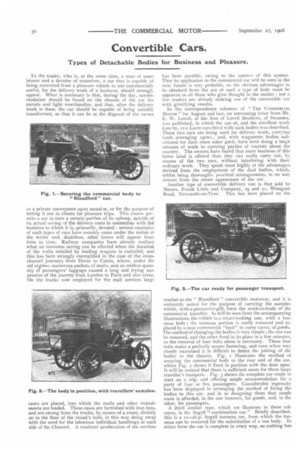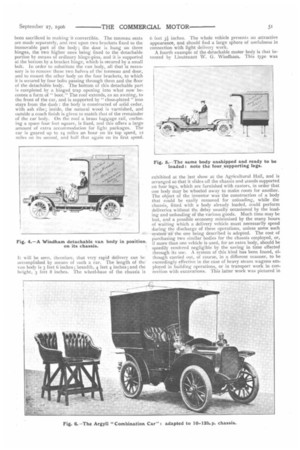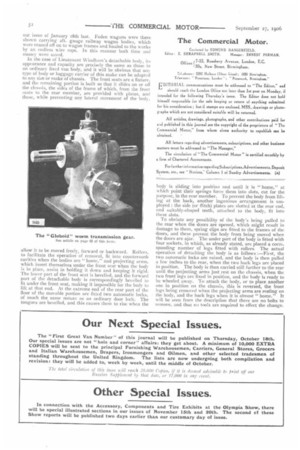Convertible Cars.
Page 2

Page 3

Page 4

If you've noticed an error in this article please click here to report it so we can fix it.
Types of Detachable Bodies for Business and Pleasure.
To the trader, who is, at the same time, a man of some leisure and a devotee of motorism, a car that is capable of being converted from a pleasure vehicle to one commercially useful, for the delivery work of a business, should strongly appeal. What is necessary is that, during the day, accommodation should be found on the chassis of the car for parcels and light merchandise, and that, after the delivery work is done, the car should be capable of being suitably transformed, so that it can be at the disposal of the owner
as a private conveyance upon occasim, or for the purpose of letting it out to clients for pleasure trips. This course permits a car to earn a certain portion of its upkeep, outside of its actual saving of the delivery costs in connection with the business to which it is, primarily, devoted : several examples of such types of cars have recently come under the notice of the writer and, doubtless, other forms will appear from time to time. Railway companies have already realised what an immense saving can be effected when the duration of the waits entailed by loading wagons is curtailed, and this has been strongly exemplified in the case of the crosschannel journeys from Dover to Calais, where, under the old regime, numerous packets of mails, and an endless quantity of passengers' luggage caused a long and trying suspension of the journey from London to Paris and vice versa. On the trucks now employed for the mail services large cases are placed, into which the mails and other impedimenta are loaded. These cases are furnished with iron eyes, and are swung from the trucks, by means of a crane, directly on to the floor of the vessel's hold, in this way doing away with the need for the laborious individual handlings at each side of the Channel. A resultant acceleration of the services has been possible, owing to the SLICCCS of this system. That its application to the commercial car will be seen in the near future is very probable, as the obvious advantages to be obtained from the use of such a type of body must be apparent to all those who give thought to the matter : not a few traders are already making use of the convertible car with gratifying results.
In the correspondence columns of "TIM COMMERCIAL MOTOR " for August 2nd last, an interesting letter from Mr. E. W. Lovell, of the firm of Lovell Brothers, of Swansea, was published, in which the use of, and the excellent work done by, two Lacre cars fitted with such bodies was described. These two cars are being used for delivery work, carrying loads averaging iscwt., and, with wagonette bodies substituted for their more sober garb, have been doing a large amount of work in carrying parties of tourists about the country. The owners have found that more business of this latter kind is offered than they can really carry out, by means of the two cars, without interfering with their ordinary work. They speak most highly ot the advantages derived from the employment of the dual bodies, which, whilst being thoroughh practical arrangements, in no way detract from the smart appearance of the car.
Another type of convertible delivery van is that sold by Messrs. Frank Little and Company, 19 and 21, Westgate Road, Newcastle-on-Tyne. This has been placed on the market as the " Blandford " convertible motorcar, and it is eminently suited for the purpose of carrying the samples which, with a persuasive gift, form the stock-in-trade of the commercial traveller. As will be seen from the accompanying illustrations, the vehicle is a smart-looking one, with a tonneau body ; the tonneau portion is easily removed and replaced by a neat commercial "boot" to carry 12cwt. of goods. The method of changing the bodies is very simple ; the one can be removed, and the other fixed in its place in a few minutes, as the removal of four bolts alone is necessary. These four bolts make a perfectly secure fastening, and even when very closely examined it is difficult to detect the joining of the bodies to the chassis. Fig. I illustrates the method of securing the commercial body to the rear end of the car, whilst Fig. 2 shows it fixed in position with the door open. It will be noticed that there is sufficient room for three large traveller's hampers. Fig. 3 shows the complete car ready to start on a trip, and offering ample accommodation for a party of four or five passengers. Considerable ingenuity has been displayed in arranging the method of fixing the bodies to this car, and in so designing them that ample room is afforded, in the one instance, for goods, and, in the other, for passengers.
A third similar type, which we illustrate in these columns, is the Argyll "combination car." Briefly described, this is a toi2h.p. Argyll tonneau car, from which the tonneau can be removed for the substitution of a van body. In either form the car is complete in every way, as nothing has
been sacrificed in making it convertible. The tonneau seats are made separately, and rest upon two brackets fixed to the immovable part of the body ; the door is hung on three hinges, the two higher ones being fixed to the detachable portion by means of ordinary hinge-pins, and it is supported at the bottom by a bracket hinge, which is secured by a small bolt. In order to substitute the van body, all that is necessary is to remove these two halves of the tonneau and door, and to mount the other body on the four brackets, to which it is secured by four bolts passing through them and the floor of the detachable body. The bottom of this detachable part is completed by a hinged trap opening into what now becomes a form of" boot." The roof extends, as an awning, to the front of the car, and is supported by " close-plated " iron stays from the dash : the body is constructed of solid cedar, with ash ribs ; inside, the natural wood is varnished, and outside a coach finish is given to match that of the remainder of the car body. On the roof a brass luggage rail, enclosing a space four feet square, is fixed, and this offers a large amount of extra accommodation for light packages. The car is geared up to 24 miles an hour on its top speed, 12 miles on its second, and half that again on its first speed.
IL will be seen, therefore, that very rapid delivery can be accomplished by means of such a car. The length of the van body is 3 feet 6 inches ; breadth, 4 feet 4 inches ; and the height, 3 feet 8 inches. The wheel-base of the chassis is
6 feet 3i inches. The whole vehicle presents an attractive appearance, and should find a large sphere of usefulness in connection with light delivery work. A fourth example of the detachable motor body is that invented by Lieutenant W. G. Windham. This type was
exhibited at the last show at the Agricultural Hall, and is arranged so that it slides off the chassis and stands supported on four legs, which are furnished with castors, in order that one body may be wheeled away to make room for another. The object of the inventor was the construction of a body that could be easily removed for unloading, while the chassis, fitted with a body already loaded, could perform deliveries without the delay usually occasioned by the loading and unloading of the various goods. Much time may be lost, and a possible economy minimised by the many hours of waiting which a delivery vehicle must necessarily spend during the discharge of these operations, unless some such system as the one being described is adopted. The cost of purchasing two similar bodies for the chassis employed, or, if more than one vehicle is used, for an extra body, should be speedily rendered negligible by the saving in time effected through its use. A system of this kind has been found, although carried out, of course, in a different manner, to be exceedingly effective in the case of heavy steam wagons employed in building operations, or in transport work in connection with excavations. This latter work was pictured in
our issue of January 18th last. Foden wagons were there shown carrying 2ft. gauge railway wagon bodies, which were craned off on to wagon frames and hauled to the works by an endless wire rope. In this manner both time and money were saved.
In the case of Lieutenant Windham's detachable body, its appearance and capacity are precisely the same as those in an ordinary fixed van body, and it will be obvious that an type of body or luggage carrier of this make can be adapted to any size or make of chassis. The front seats are a fixture, and the remaining portion is built so that it slides on or off the chassis, the sides of the frame of which, from the front seats to the rear member, are provided with plates, and these, while preventing any lateral movement of the body, allow it to be moved freely, forward or backward. Rollers, to facilitate the operation of removal, fit into countersunk cavities when the bodies are "home," and projecting arms, which insert themselves under the front seat when the body is in place, assist in holding it down and keeping it rigid. The lower part of the front seat is bevelled, and the forward part of the detachable body is correspondingly bevelled to fit under the front seat, making it impossible for the body to lift at that end. At the extreme end of the rear part of the floor of the movable portion are fitted two automatic locks, of much the sante nature as an ordinary door lock. The tongues are bevelled, and this causes them to rise when the
body is sliding into position and until it is " home," at which point their springs force them into slots, cut for the purpose, in the rear member. To prevent the body from lifting at the back, another ingenious arrangement is employed: the side (or flitch) plates are slotted at the rear end, and suitably-shaped teeth, attached to the body, fit into these slots_ To obviate any possibility of the body's being pulled to the rear when the doors are opened, which might result in damage to them, spring clips are fitted to the frames of the doors, and these prevent the body from being moved when the doors are ajar. The under part of the body is fitted with four sockets, in which, as already stated, are placed a corresponding number of legs fitted with rollers. The actual operation of detaching the body is as follows :—First, the two automatic locks are raised, and the body is then pulled a few inches to the rear, when the two back legs are placed in position. The body is then carried still further to the rear until the projecting arms just rest on the chassis, when the two front legs are fixed in position, and the body is ready to be wheeled away. To attach the body, or to place another one in position on the chassis, this is reversed, the front legs being removed when the projecting arms are resting on the body, and the back legs when it is almost " home." It will be seen from the description that there are no bolts to remove, and that no tools are required to effect the change.


























